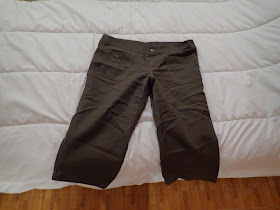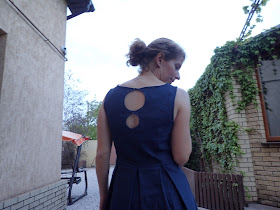My favourite pair of summer pants:
They are so threadbare that I was almost worried a copy would be too big because the fibers have relaxed a lot in the past five years of wear. I had debated copying them myself by taking them apart. I was right to consider this an urgent matter, as later on this trip they fell apart spectacularly by ripping open across the entire bottom.
Interestingly, the shop in Bangkok said that the tracing method is much easier than taking a piece apart. I would assume it's less precise for some reason.
Copy number 1 is in a medium weight cotton:
Copy number 2 in silk Ikat from Bangkok:
Unfortunately I forgot to ask the guys to give me all my scraps. I am pretty sad about that as I bought 1.5 meters. Because of the width of the looms, thai silk is always about 1 meter wide, but I am pretty sure there was a lot left over. The tailor cut on the cross grain to maintain the pattern and I was pleased with his pattern placement on the waistband and pockets.
Final opinion after wear: I did this in the nick of time! The waistband on both new versions is too big, but I'm hoping it'll shrink with a wash. It doesn't make them unwearable by any means. They are of course stiffer than my aged originals. This copy project took two days!! It cost me about $30 per pair, plus about $6 for the brown fabric. Everything is finished nicely on the insides. I may regret asking for no belt loops because of this - I realised when they ripped that as the originals got looser they hung lower and lower on me, and fit less well.
Unfortunately I was in a rush when I paid, so I can't tell you who the guys were in Bangkok that made my copies. If you care, I can give you directions. They were lovely gentlemen with good English, and they are good enough that they have clients in Switzerland and actually fly there to measure these dudes. I think they aren't the cheapest out there - so far in Thailand there are sewists literally on every corner but I can't speak for the quality of everyone.
 |
| sorry very small picture |
They are so threadbare that I was almost worried a copy would be too big because the fibers have relaxed a lot in the past five years of wear. I had debated copying them myself by taking them apart. I was right to consider this an urgent matter, as later on this trip they fell apart spectacularly by ripping open across the entire bottom.
Interestingly, the shop in Bangkok said that the tracing method is much easier than taking a piece apart. I would assume it's less precise for some reason.
Copy number 1 is in a medium weight cotton:
Copy number 2 in silk Ikat from Bangkok:
Unfortunately I forgot to ask the guys to give me all my scraps. I am pretty sad about that as I bought 1.5 meters. Because of the width of the looms, thai silk is always about 1 meter wide, but I am pretty sure there was a lot left over. The tailor cut on the cross grain to maintain the pattern and I was pleased with his pattern placement on the waistband and pockets.
Final opinion after wear: I did this in the nick of time! The waistband on both new versions is too big, but I'm hoping it'll shrink with a wash. It doesn't make them unwearable by any means. They are of course stiffer than my aged originals. This copy project took two days!! It cost me about $30 per pair, plus about $6 for the brown fabric. Everything is finished nicely on the insides. I may regret asking for no belt loops because of this - I realised when they ripped that as the originals got looser they hung lower and lower on me, and fit less well.
Unfortunately I was in a rush when I paid, so I can't tell you who the guys were in Bangkok that made my copies. If you care, I can give you directions. They were lovely gentlemen with good English, and they are good enough that they have clients in Switzerland and actually fly there to measure these dudes. I think they aren't the cheapest out there - so far in Thailand there are sewists literally on every corner but I can't speak for the quality of everyone.





















































